Essential senior fitness equipment includes low-impact options like recumbent bikes and ellipticals that protect your joints while improving heart health. Add resistance bands and light dumbbells for strength, and balance boards or stability balls to prevent falls. Look for adjustable resistance settings, supportive seating, and emergency stop features for safety. Space-saving choices like pedal exercisers and foldable equipment work well for home use. Discover how these tools can transform your fitness journey while keeping you safe.
Why Exercise Equipment Matters for Seniors
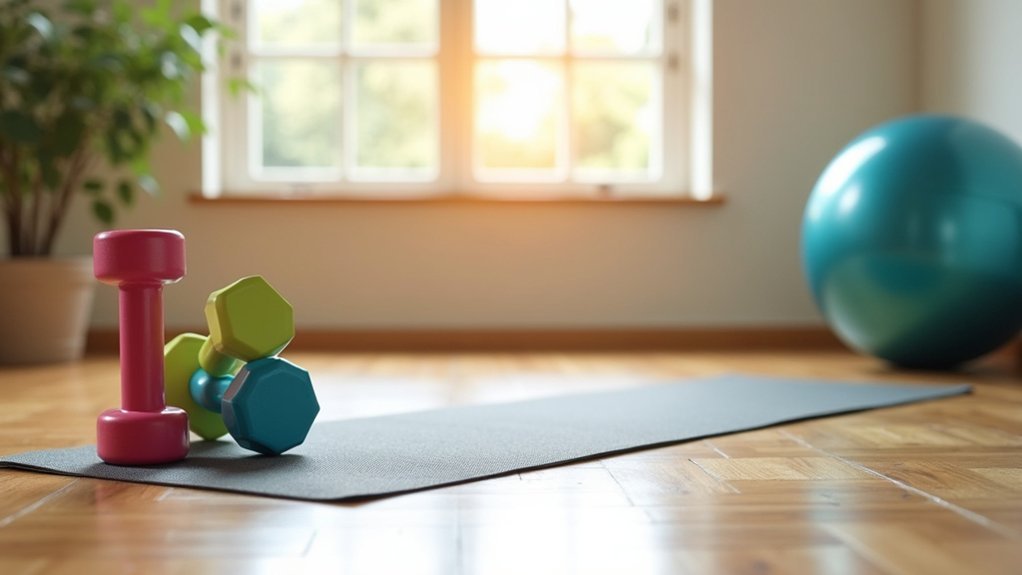
Safety stands at the forefront of senior exercise considerations. When you choose equipment with proper supports like handrails and joint-friendly designs, you greatly reduce your risk of falls and injuries while exercising independently.
The right fitness tools do more than protect you—they transform your health. Regular exercise helps maintain your muscle mass, enhances bone density, and reduces your risk of chronic diseases. Engaging in low-impact workout options is particularly recommended for seniors as they prevent joint strain while still providing effective exercise benefits.
Exercise isn’t just safe—it’s transformative, preserving vital muscle mass while protecting bones and warding off disease.
You’ll notice improved balance, coordination, and mental well-being with consistent activity.
Exercise equipment also opens doors to social connections. Community-based fitness programs and outdoor equipment create opportunities for meaningful interactions with others.
These shared experiences combat isolation while providing motivation and support. With the right equipment, you’ll gain greater independence, better sleep quality, and renewed confidence in your physical abilities.
Top Cardiovascular Machines for Joint-Friendly Workouts
When choosing cardiovascular equipment for joint health, you’ll find ellipticals and recumbent bikes offer exceptional low-impact options for seniors.
Ellipticals provide a full-body workout that mimics natural walking patterns without stress on your knees, while recumbent bikes feature supportive seating that protects your back during exercise.
Both machines include essential heart rate monitoring features to help you maintain appropriate intensity levels for cardiovascular benefits without overexertion. SOLE Fitness offers premium options ranging from $499.99 to $1,799.99 depending on the model and features you require.
Ellipticals vs. Recumbent Bikes
Why do many seniors face the dilemma of choosing between ellipticals and recumbent bikes?
Both offer excellent low-impact options for maintaining fitness while protecting vulnerable joints, but they serve different needs and preferences.
Consider these key differences when making your choice:
- Full-body engagement – Ellipticals work both upper and lower body muscles, while recumbent bikes primarily target leg muscles.
- Comfort level – Recumbent bikes provide superior back support with comfortable seating for longer workouts.
- Calorie burn – Ellipticals typically burn more calories due to their full-body workout nature.
- Joint protection – Both are gentle, but recumbent bikes may be better for those with significant back issues due to their supportive seated position. Recumbent cross-trainers offer an excellent alternative as they combine the seated position with linear pedal motion that significantly reduces stress on joints.
Your specific health needs and fitness goals should guide your final decision.
Heart-Healthy Movement Options
Beyond the elliptical versus recumbent bike decision, numerous cardiovascular machines offer excellent heart-healthy benefits while protecting aging joints.
Rowing machines deliver a full-body workout while you remain seated, targeting multiple muscle groups with adjustable resistance to match your fitness level.
Treadmills provide controlled walking environments with cushioned surfaces that reduce impact. Their handrails and safety features like emergency stop keys make them particularly suitable if you’re concerned about balance. Elliptical cross trainers offer minimal impact on joints, making them an excellent option for seniors looking to maintain fitness without strain.
Don’t overlook simpler options that can complement your cardio routine.
Resistance bands build strength without expensive equipment, while stability balls improve core strength and balance. Foam rollers help maintain flexibility, and free weights add variety to your strength training regimen.
Choose equipment that matches your specific health needs and fitness goals for sustainable heart health.
Strength Training Options for Maintaining Muscle Mass
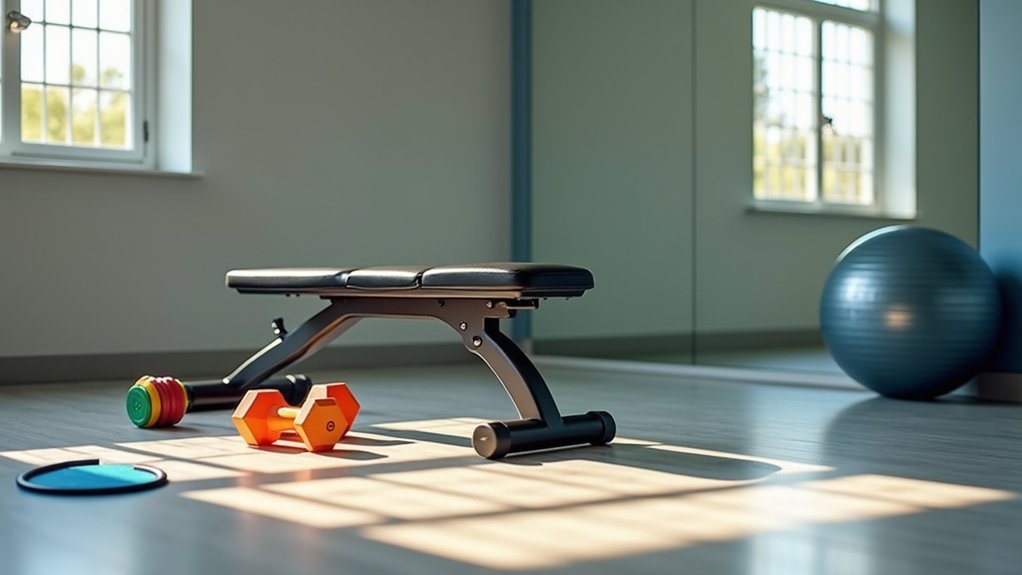
As we age, maintaining muscle mass becomes increasingly critical for overall health and independence.
You’ll find several equipment options perfectly suited for senior strength training that are both effective and joint-friendly.
Resistance bands offer versatile, low-impact strengthening that’s ideal for beginners or rehabilitation.
Meanwhile, machines like the leg press and chest press provide guided motions that reduce injury risk while effectively targeting specific muscle groups.
Weight machines with adjustable settings accommodate various fitness levels while providing a safe environment for building strength.
For home use, consider these essential items:
- Light dumbbells (like Portzon’s non-slip set) for upper body strength
- Resistance bands with varying tension levels for full-body workouts
- Under desk pedal exercisers for convenient leg strengthening
- Chair-based exercise programs specifically designed for seniors
Remember to complement your strength training with proper nutrition and hydration for best results.
Balance and Flexibility Equipment to Prevent Falls
Falls represent one of the most serious health risks for seniors, with nearly 30% experiencing a fall each year. Investing in balance equipment can greatly improve your stability, confidence, and overall mobility.
Self-standing balance poles provide lightweight support during exercises, while stability balls strengthen your core. Consider foam rollers to enhance flexibility and aid muscle recovery. Balance boards are excellent for improving coordination while engaging core muscles. The 60 and Up Balance Board offers specific senior features designed to reduce fall risk.
For a thorough approach, incorporate chair workouts into your routine for added stability. When selecting equipment, look for accessibility features like low insteps and support rails. The best tools will offer clear progress tracking and customized recommendations based on your abilities.
Regular balance training not only prevents falls but enhances your quality of life through improved coordination and physical confidence.
Space-Saving Fitness Solutions for Home Use
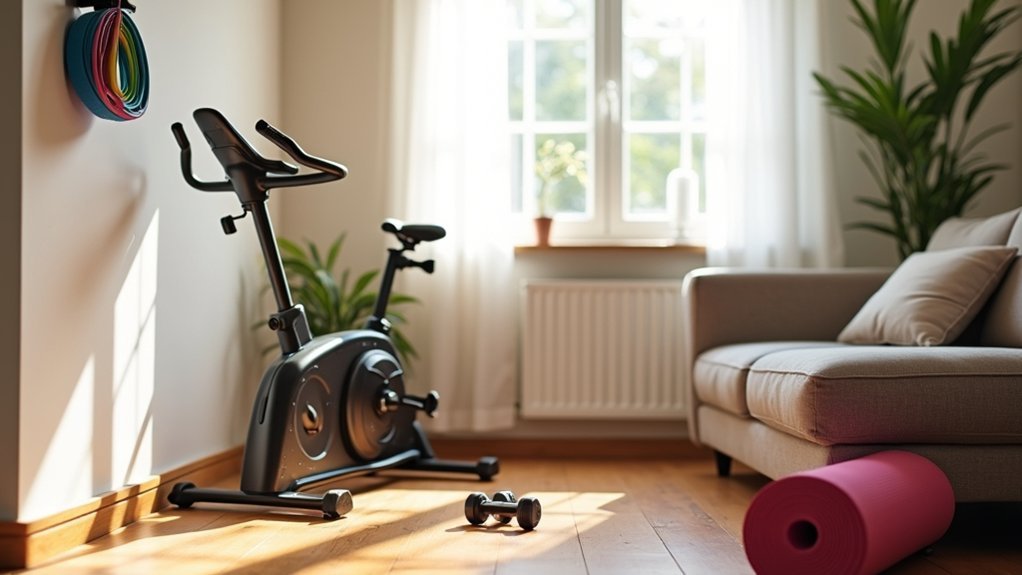
Limited living space shouldn’t hinder your fitness journey.
Small space? Big fitness potential. Your workout dreams fit anywhere with the right approach.
Today’s equipment offers innovative designs that maximize functionality while minimizing spatial footprint. Foldable treadmills and compact ellipticals provide effective workouts and can be tucked away when not in use. Recumbent bikes offer comfortable workouts with excellent back support for those with mobility concerns.
For the most space-efficient home gym, consider these smart options:
- Multi-purpose devices that combine several functions into one unit, eliminating the need for multiple pieces.
- Resistance bands for strength training that store in a drawer when not needed.
- Compact pedal exercisers you can use while watching TV and slide under furniture afterward.
- Folding equipment with quick-collapse features for easy storage in closets or under beds.
Always prioritize gear with non-slip surfaces and stability features for your safety.
Low-Impact Machines That Maximize Results
You can achieve impressive fitness results without stressing your joints by choosing the right low-impact exercise machines.
Recumbent bikes, ellipticals, and rowing machines offer effective cardiovascular workouts while minimizing pressure on knees, hips, and ankles.
These machines let you control resistance levels to gradually increase intensity as your fitness improves, making them perfect for pain-free progress. Many also include safety features like sturdy handles and anti-slip pedals that give seniors more confidence during their workouts.
Joint-Friendly Workout Machines
As we age, finding exercise equipment that’s gentle on the joints becomes increasingly important for maintaining fitness without pain or injury.
Low-impact machines provide effective workouts while minimizing strain on sensitive joints.
When selecting joint-friendly equipment, consider these options:
- Elliptical trainers – Mimic natural walking motion while supporting both upper and lower body exercise without impact.
- Recumbent bikes – Offer comfortable seating with back support, reducing pressure on knees and hips.
- Rowing machines – Engage multiple muscle groups simultaneously with smooth, controlled movements.
- Under desk pedal exercisers – Allow for convenient exercise while seated, perfect for those with limited mobility.
The SOLE E25 Elliptical is especially beneficial as it was designed by physical therapists specifically to support joint health with its 20 incline levels.
Look for machines featuring adjustable resistance, supportive handles, and digital displays to track your progress.
Always start gradually and maintain proper form to prevent injury.
Exercise Without Pain
Finding effective exercise equipment that doesn’t aggravate existing joint pain represents a key challenge for many seniors. Elliptical machines offer an excellent solution, providing cardiovascular benefits while minimizing stress on your knees and hips.
Stationary bikes deliver similar advantages, allowing you to improve lung capacity and endurance without jarring impacts.
For full-body conditioning, consider rowing machines that engage multiple muscle groups simultaneously while remaining gentle on joints. Many seniors have experienced increased adherence to their fitness routines by using technology that offers heart rate monitoring to ensure safe and effective workouts.
You’ll appreciate that these machines often include safety features like emergency stop buttons and cushioned surfaces. Many models are also designed with space efficiency in mind, fitting comfortably in your home environment.
The best part? You won’t sacrifice results when choosing low-impact options.
These machines effectively support weight management, muscle strengthening, and improved balance—all critical fitness goals for your long-term health.
Accessible Features to Look for When Choosing Equipment
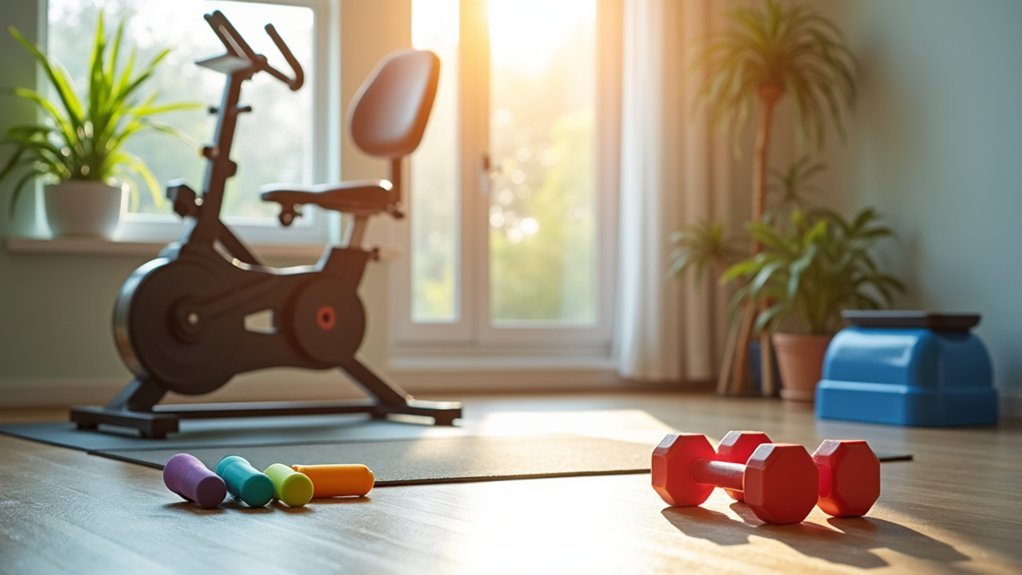
When selecting fitness equipment for seniors, what accessible features truly make a difference in usability and safety? Look for pneumatic technology like HUR’s Accessible Line with zero starting load—ideal for beginners and rehabilitation. The equipment’s pneumatic technology follows natural movement and is easy on joints, making it particularly suitable for seniors. Equipment should accommodate wheelchair users while offering versatility for everyone.
- Adjustable resistance settings that can be customized to individual capabilities, allowing gradual progression.
- User-friendly interfaces with touchscreens and automated programs that reduce intimidation and staff intervention.
- Supportive seating options including rollaway seats that accommodate both wheelchair and non-wheelchair users.
- Smart technology integration for tracking progress and providing safety alerts when needed.
These features not only improve accessibility but also increase participation rates and foster community engagement among seniors.
Budget-Friendly Fitness Tools for Seniors
Staying physically active doesn’t require expensive equipment or gym memberships. Resistance bands ($10-$100) offer versatile strength training options while taking up minimal space.
Pair these with workout sliders (under $10) for effective core exercises that won’t strain your joints. Light dumbbells provide accessible strength training, while an exercise ball (around $19) improves balance and core stability.
Don’t forget a basic yoga mat for comfort during floor exercises. Health experts recommend at least 150 minutes weekly of moderate exercise for seniors to maintain cardiovascular health.
If you’re looking for cardio equipment, consider used or refurbished options. Compact rowing machines and folding treadmills save space while providing low-impact workouts.
Recumbent bikes offer cardiovascular benefits with minimal joint stress—perfect if you have mobility concerns.
Best Equipment Combinations for Complete Senior Fitness
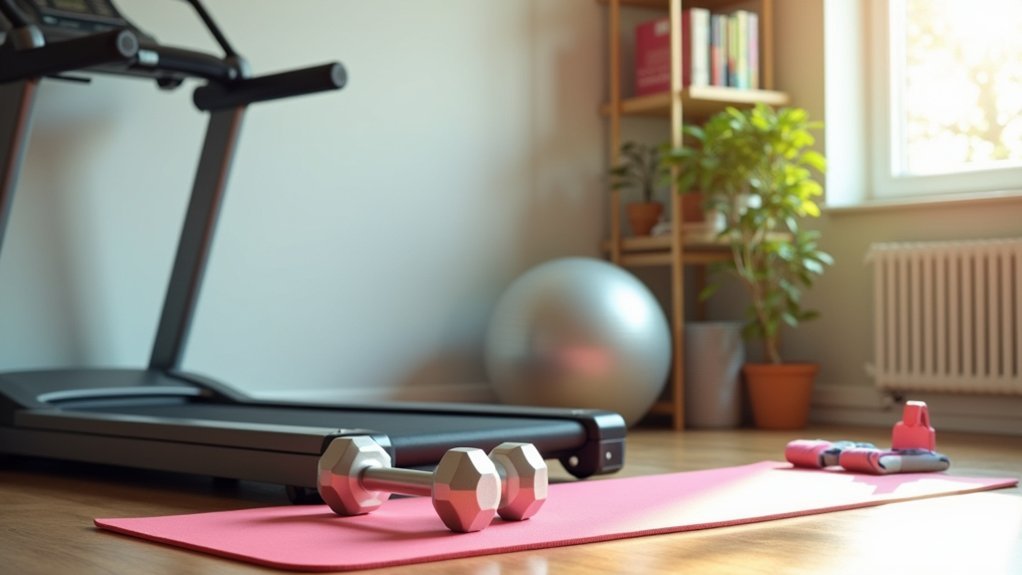
Creating a well-rounded fitness routine requires strategic equipment combinations that address all aspects of senior health.
You’ll achieve better results by pairing complementary equipment that targets different fitness needs while maintaining safety.
- Cardio + Strength: Combine a recumbent bike with resistance bands to improve heart health while building muscle strength in a low-impact, joint-friendly way.
- Balance + Flexibility: Pair a stability ball with a yoga mat for exercises that enhance core stability while improving range of motion. Remember that choosing the correct ball size is crucial for maintaining proper posture and preventing potential injuries during your workout.
- Full-Body + Low-Impact: Use a rowing machine with adjustable resistance alongside loop bands to engage multiple muscle groups without strain.
- Home-Friendly Combo: Invest in walking pads and kettlebells for space-efficient options that improve both cardiovascular health and strength.
Adjusting Workout Equipment for Different Mobility Levels
You’ll need to adjust equipment to accommodate joint limitations by selecting machines with low-impact options and customizable resistance levels.
Consider equipment height, ensuring seats are easily accessible and controls within reach for seniors with limited mobility.
For those needing extra assistance, look for workout equipment with support features like stability bars, swivel seats, and adaptive accessories that enable safe and effective exercise despite physical limitations. NuStep recumbent cross trainers include WellGrip accessories that provide essential support for users with muscular weakness.
Modifying for Joint Limitations
As we age, our joints often require special consideration during exercise, making equipment modification essential for seniors with mobility limitations.
You’ll find that standard fitness equipment can strain arthritic joints, but several adaptations can make your workouts both effective and comfortable.
When selecting joint-friendly equipment, focus on these key modifications:
- Choose pneumatic resistance systems like HUR, which offer gentler resistance with precise, small increments (.25 lb) and zero starting loads.
- Opt for low-impact machines such as ellipticals or recumbent bikes that follow natural movement patterns.
- Look for equipment with easy on/off features and wheelchair accessibility options.
- Select machines with programmable workouts that include heart rate monitoring to keep you in safe exercise zones.
Traditional equipment often poses significant risk as tens of thousands of people are hospitalized annually due to exercise equipment injuries.
Equipment Height Considerations
Proper equipment height adjustments serve as the foundation for safe and effective workouts among seniors with varying mobility levels.
You’ll want to focus on equipment with adjustable seats, handlebars, and resistance settings that accommodate your specific needs.
When selecting fitness equipment, look for stationary bikes with easy-to-adjust seats and recumbent bikes that offer additional back support.
Elliptical machines and treadmills should feature accessible handrails and user interfaces.
The stability of your equipment is equally important—wider bases prevent wobbling and enhance safety.
Always prioritize equipment with emergency brakes to ensure you can stop immediately if you experience discomfort or instability during your workout.
Remember that properly adjusted equipment not only improves comfort but also reduces injury risk and optimizes workout efficiency.
Whether you’re recovering from joint issues or maintaining an active lifestyle, customizable equipment allows you to progress at your own pace while supporting proper form.
Assisted Exercise Options
Assisted exercise equipment offers a gateway to fitness for seniors with varying mobility challenges.
These machines feature adjustable resistance levels and supportive elements like handlebars that prevent falls while ensuring proper form during workouts.
For different mobility needs, consider these adaptable options:
- Recumbent bikes – Provide seated cardiovascular exercise with back support and easy entry/exit points.
- Elliptical trainers – Offer low-impact movement with supportive handlebars for balance.
- Resistance bands – Allow customizable tension for strength training without heavy weights.
- Mini steppers – Deliver gentle stepping motions with stability rails for joint-friendly workouts.
You’ll find these options in senior centers, public parks, and rehabilitation facilities where they’re often equipped with digital displays to track your progress and heart rate during exercise sessions. The availability in various locations makes these equipment options particularly beneficial as they support independent exercise routines while accommodating all fitness levels.
Frequently Asked Questions
How Often Should Seniors Replace Their Fitness Equipment?
You should replace fitness equipment every 3-10 years depending on quality and usage. Maintain your items regularly and check for safety issues monthly. Replace immediately if equipment shows damage or poses safety risks.
Can Seniors With Pacemakers Safely Use Electronic Fitness Machines?
If you have a pacemaker, consult your doctor before using electronic fitness machines. Avoid equipment with strong magnetic fields and keep a safe distance from electronic components to minimize potential interference with your device.
What Equipment Works Best for Seniors With Parkinson’s Disease?
You’ll benefit from Theracycles that use “forced exercise” technology, GlideTrak for BIG WALK training, and balance tools like balance boards and discs. Resistance bands and pole walking equipment also help manage Parkinson’s symptoms effectively.
Are Medicare or Insurance Benefits Available for Fitness Equipment Purchases?
Original Medicare generally doesn’t cover fitness equipment unless it’s medically necessary DME with a doctor’s prescription. However, some Medicare Advantage plans offer fitness benefits or programs like SilverSneakers that may provide equipment access.
How Can Caregivers Safely Spot Seniors Using Home Exercise Equipment?
You should closely monitor seniors, stand within arm’s reach, and provide clear instructions. Learn proper spotting techniques for each exercise, maintain eye contact, and be ready to assist immediately if they’re struggling.
In Summary
You’ve now got all the tools to create a senior-friendly home gym that works for your unique needs. Remember, it’s not about having every piece of equipment, but choosing what supports your mobility, strength, and balance goals. Start small, focus on safety features, and you’ll maintain independence longer. Even with limited space or budget, you can stay active and healthy for years to come.

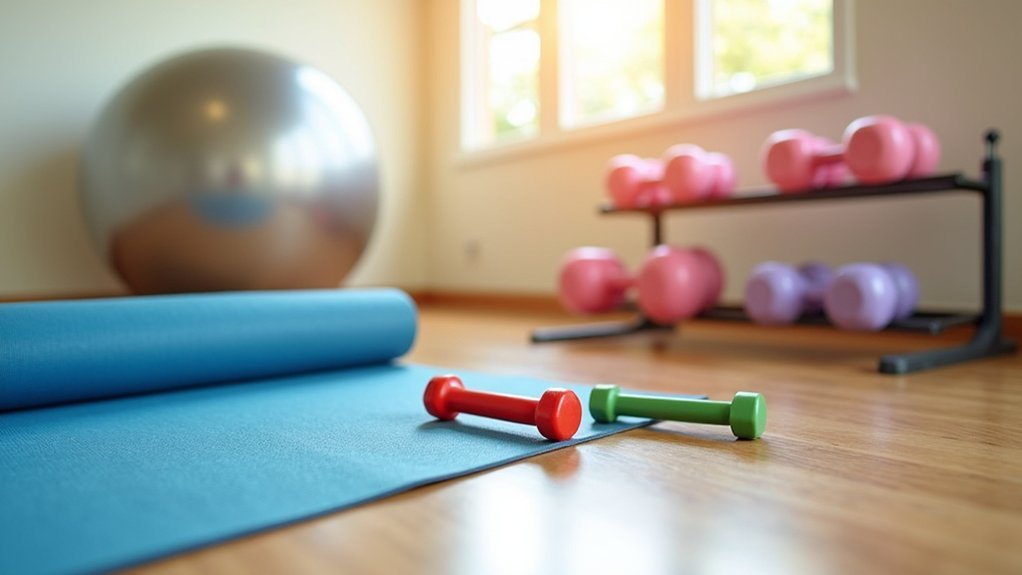
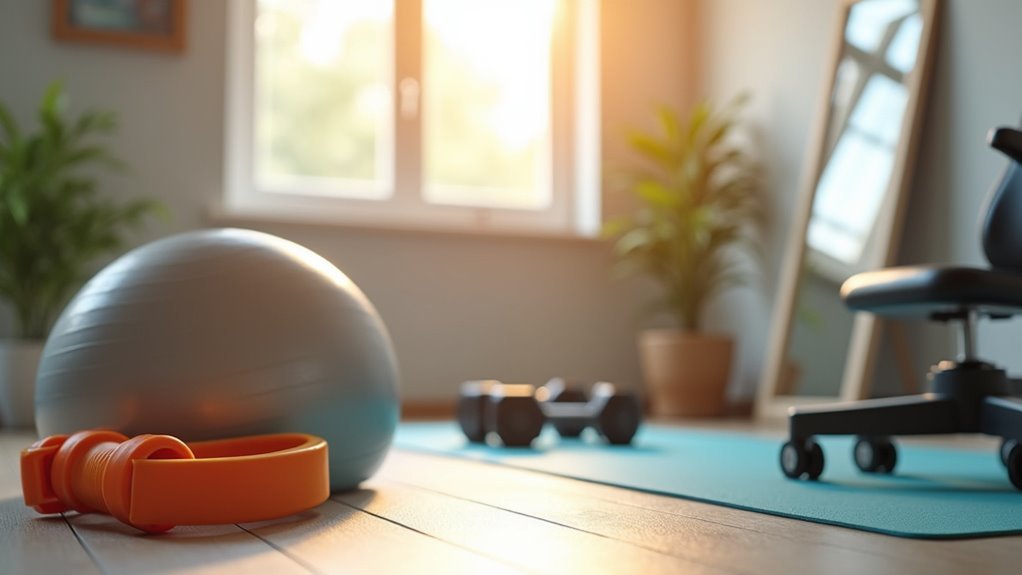
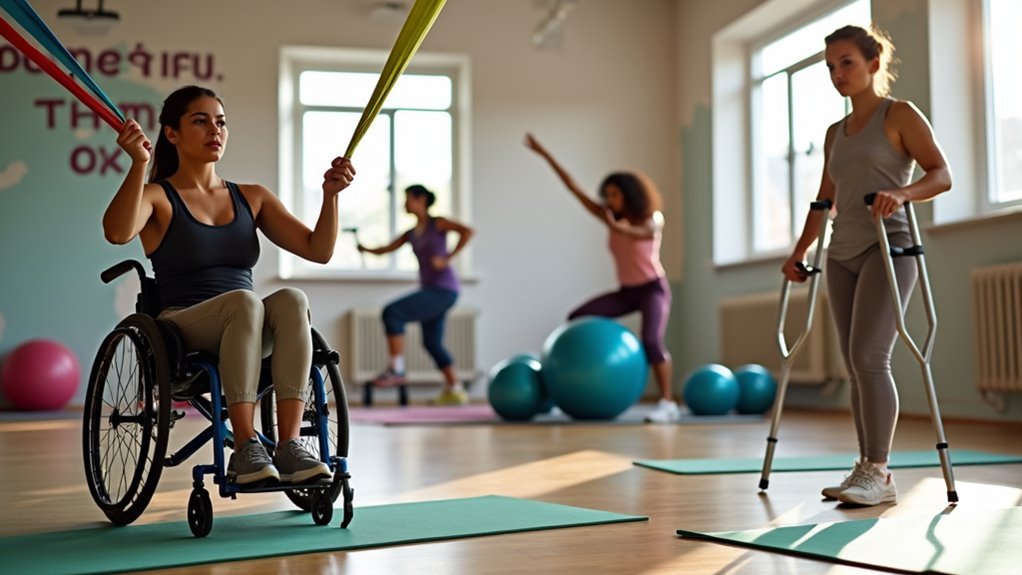
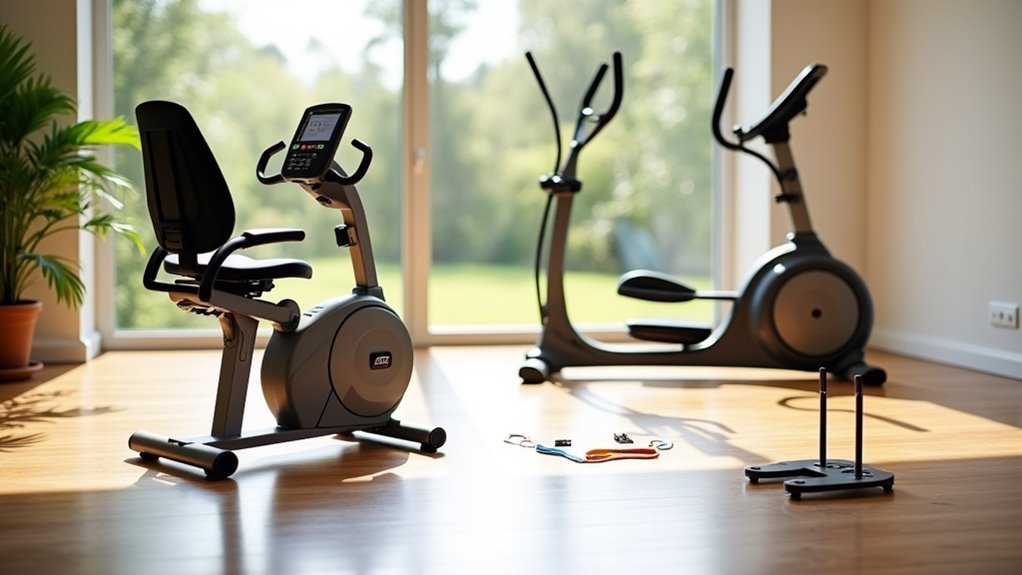
Leave a Reply